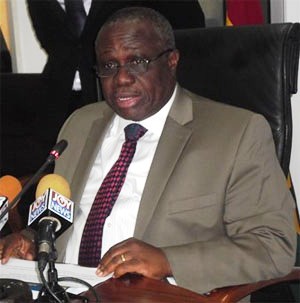The Bank of Ghana’s increase in the prime lending rate from 23% to 25% makes the country the highest in terms of interest rate in the world.
The prevailing high lending rates in the country is stifling investments, the development of the private sector and economic growth in general.
Ghana’s interest rate went up to 25% on September 14, 2015 from 24% in on August 31, 2015.
The other two countries with 25% interest rate are Belarus and Malawi.
Interest rate in Belarus was last registered at 25% on August 31, 2015 while interest rate in Malawi was reported at 25% on August 31, 2015.
The Bank of Ghana increased its benchmark interest rate by 100bps to 25% on September 14, 2015, aiming to curb inflationary pressures.
Interest rate in Ghana averaged 16.99% from 2002 until 2015, reaching an all-time high of 27.50% in March of 2003 and a record low of 12.50% in December of 2006.
High-interest rate had consistently been cited by the world competitive index reports as well as in surveys by the Association of Ghana Industries as one of the major obstacles to doing business in the country.
The need for a more effective regulation on interest rates by the Central Bank as a way of reducing the high costs of credit is paramount.
The high lending rates in Ghana, in spite of historically low rates worldwide, are of monumental national importance due to its implications for the development of the private sector.
Some analysts blame competitive government borrowing as a major cause of high lending rates in the country.
The country’s high budget deficit for a long time, which is increased during election years, is financed by borrowing both domestically and internationally.
This has driven up the rates for Treasury Bills, which has become a de facto benchmark for banks’ rates.
Also, government is forced to pay relatively high-interest rates, which in turn forces the private sector to pay high rates for credit.
In addition, high costs in the banking industry covering operational costs, energy costs due to the current energy crisis, as well as structural inefficiencies, high borrower risks emanating from inadequate collateral, lack of credit referencing, un-bankable projects and general macro-economic instability have contributed to the high rates.
Internationally, the depreciation of the cedi and high-interest rate demand from foreign investors on bonds have also been contributory factors. In order to address these issues, government must restrain its borrowing by reducing the budget deficits.
Government must also consolidate the macroeconomic stability of the country.
Other remedies include increasing the efficiency of banks’ operational costs, addressing borrower risks and, most importantly, reinforcing financial regulation in Ghana.
Interest rates around the world, both short term and long term, are exceptionally low these days.
The United States of America government can borrow for 10 years at a rate of about 1.9%, and for 30 years at about 2.5%.
Rates in other industrial countries are even lower. For example, the yield on 10-year government bonds is now around 0.2% in Germany, 0.3% in Japan and 1.6% in the United Kingdom.
In Switzerland, the 10-year yield is currently slightly negative, meaning that lenders must pay the Swiss government to hold their money.
The interest rates paid by businesses and households are relatively higher, primarily because of credit risk, but are still very low on historical basis. All else equal, investors demand higher yields when inflation is high to compensate them for the declining purchasing power.
But yields on inflation-protected bonds are also very low today. The real or inflation-adjusted return on lending to the U.S. government for five years is currently about minus 0.1%.
Business News of Tuesday, 6 October 2015
Source: The Finder













